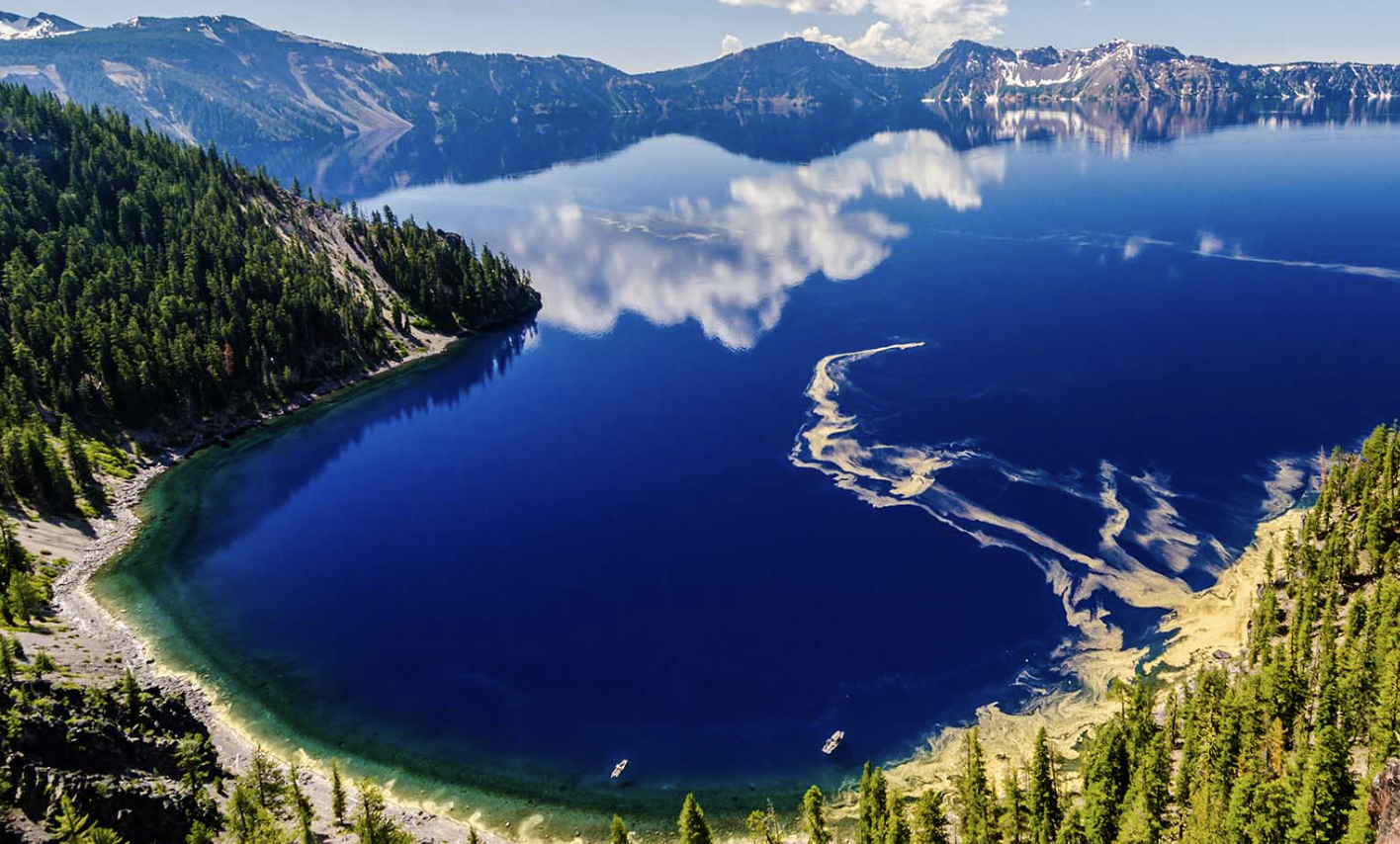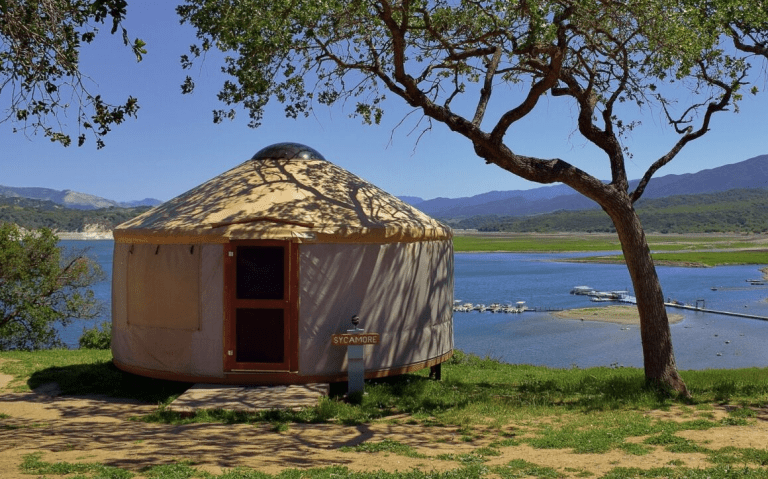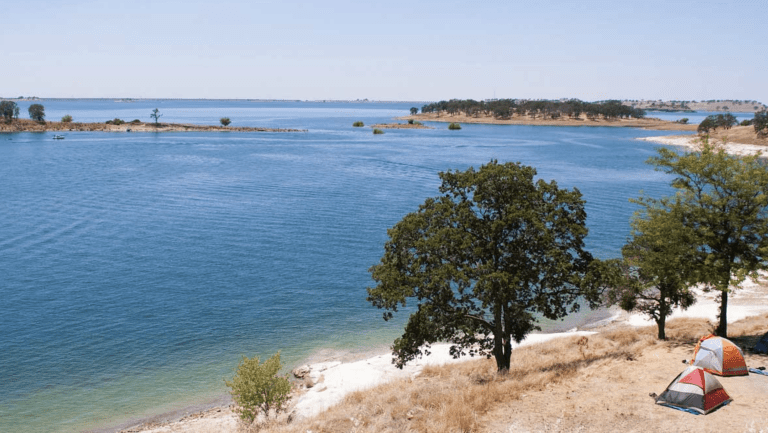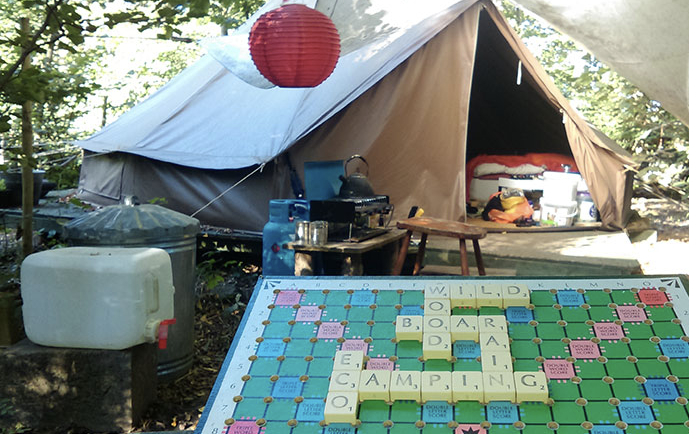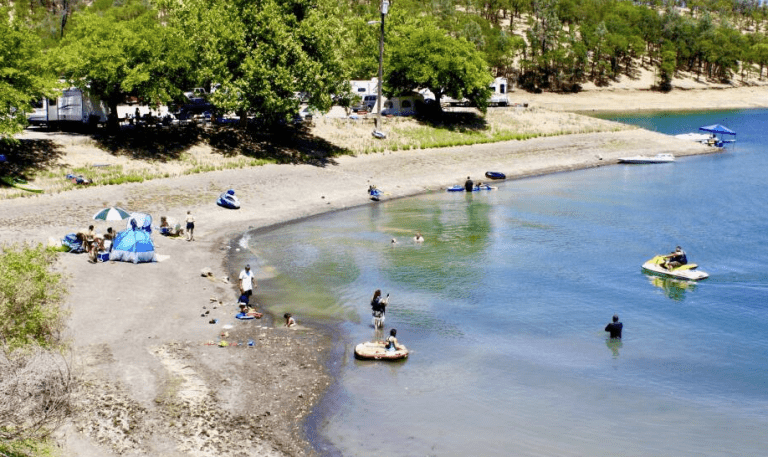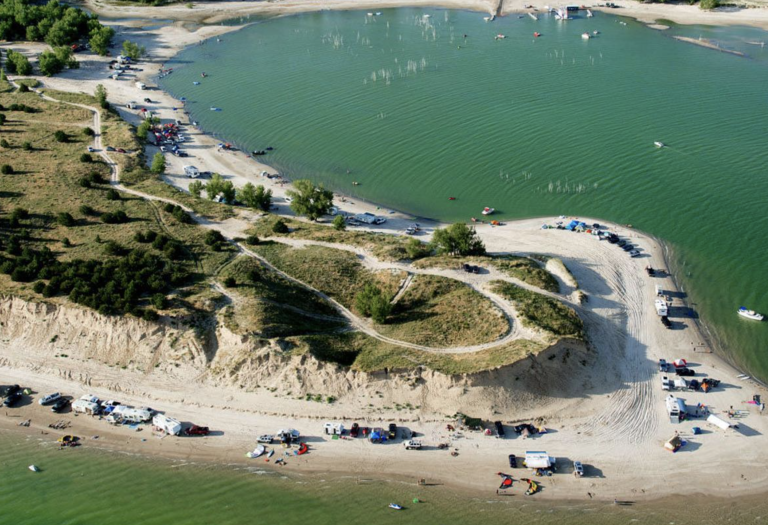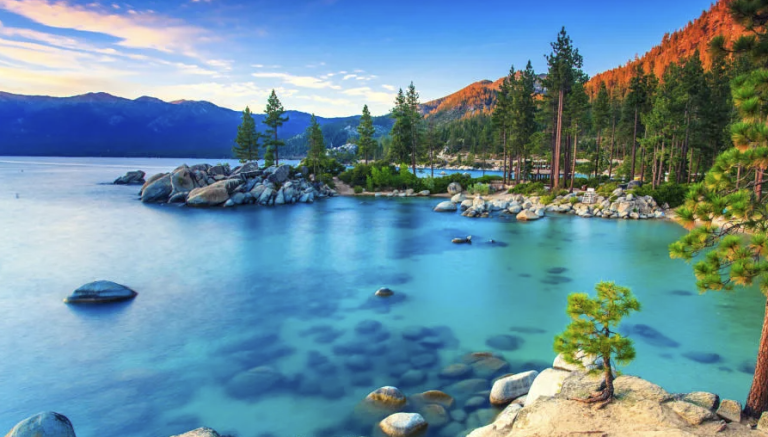Crater Lake camping offers a unique and breathtaking experience for nature enthusiasts looking to explore the beauty of this deep blue lake. Formed by Mount Mazama’s eruption over 7,700 years ago, Crater Lake National Park boasts some of the most stunning landscapes in the Pacific Northwest.
In this blog post, we will explore the formation and history of Crater Lake as well as its unique features, developed campgrounds within the park such as Mazama Village Campground and Lost Creek Campground, nearby lodging options for those seeking upscale hotels or glamping experiences, popular hiking trails in Crater Lake National Park, and Rim Drive. We’ll also discuss developed campgrounds within the park such as Mazama Village Campground and Lost Creek Campground, along with alternative lodging options nearby for those seeking upscale hotels or glamping experiences.
Furthermore, we’ll highlight popular hiking trails within Crater Lake National Park and provide insights on exploring Rim Drive. Finally, we’ll guide you through obtaining camping permits and understanding fee structures while touching upon seasonal activities like cross-country skiing during winter months and optimal times to visit for favorable weather conditions.
Crater Lake National Park Overview
Located in the heart of Oregon’s Cascade Mountains, Crater Lake National Park is a must-visit destination for outdoor enthusiasts and nature lovers alike. As the only national park in Oregon, it offers visitors a unique camping experience amidst breathtaking landscapes. The centerpiece of this stunning park is Crater Lake itself – formed by the collapse of Mount Mazama over 7,700 years ago.
The Fascinating Formation and History of Crater Lake
The story behind Crater Lake’s formation is as fascinating as its crystal-clear blue waters. Around 7,700 years ago, Mount Mazama erupted violently and collapsed upon itself due to massive magma withdrawal from its chamber. This event created a huge caldera that eventually filled with rainwater and snowmelt over time to form what we now know as Crater Lake. No inlet streams or rivers, Crater Lake is one of the most pristine bodies of water globally.
Unique Features of the Lake That Will Leave You Mesmerized
- Depth: At 1,943 feet deep (592 meters), Crater Lake holds the title for being America’s deepest lake and ranks ninth worldwide.
- Vibrant color: Due to its exceptional clarity and depth combined with sunlight absorption at different wavelengths within water molecules; you’ll be mesmerized by shades ranging from sapphire blue hues near surface levels down towards indigo depths below.
- Mysterious ecosystem: Scientists are still trying to unravel all mysteries surrounding life forms inhabiting this pristine environment such as Phantom Ship Island – home to some rare plant species found nowhere else in the world.
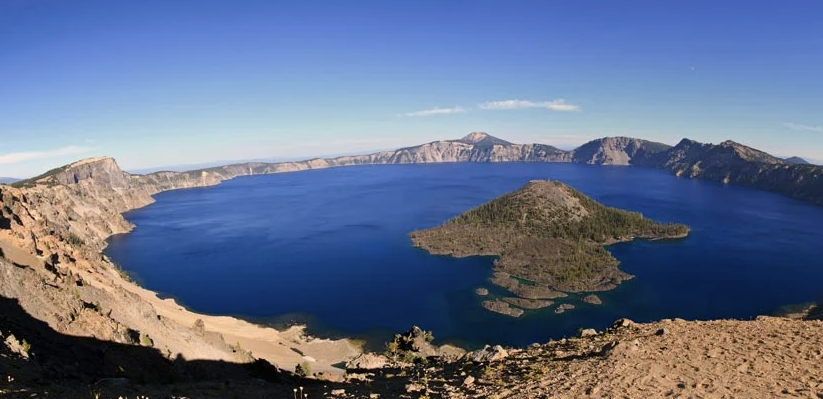
Developed Campgrounds at Crater Lake
Looking for a comfortable and convenient basecamp to explore Crater Lake National Park? Look no further than the park’s two developed campgrounds. Mazama Village Campground and Lost Creek Campground offer essential amenities and nearby attractions like Ashland’s Creekside Campground & RV Park.
Amenities at Mazama Village Campground
Mazama Village is the larger of the two campgrounds, with 214 sites that can accommodate tents and RVs up to 50 feet long. Each site comes with a picnic table, fire ring with grill grate, and access to shared restrooms with flush toilets and running water.
- Potable Water: Drinking water is available throughout the campground via spigots located near restroom facilities.
- Dump Station: A dump station is provided for RV users who need to empty their holding tanks during their stay.
- Showers & Laundry Facilities: Guests have access to coin-operated showers ($1 per token) and laundry facilities within walking distance of most campsites.
- Camp Store & Gas Station: The on-site store sells groceries, camping supplies, souvenirs, and offers gasoline services just outside the campground entrance – perfect for refueling before hitting Rim Drive.
Reservations are highly recommended for Mazama Village Campground, especially during peak season (June through September). Book your spot online or by calling the campground directly.
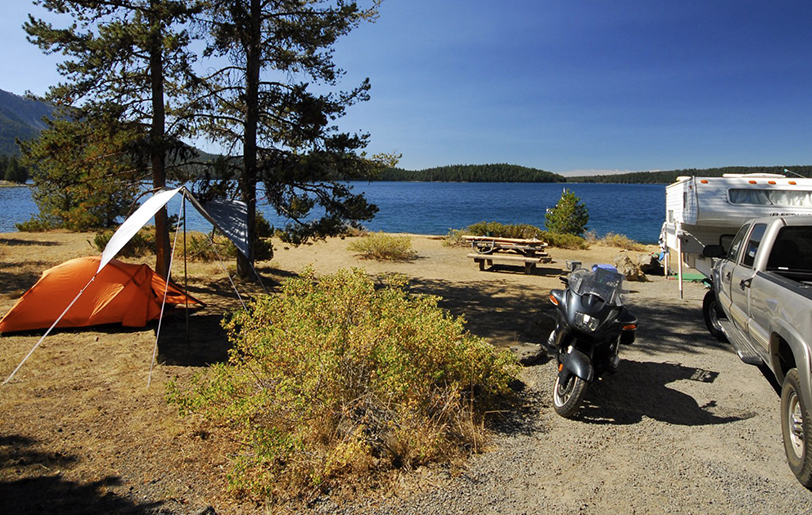
Facilities at Lost Creek Campground
For those wanting to get away from it all, Lost Creek Campground offers a tranquil and rustic camping experience. This smaller site offers 16 primitive campsites nestled within the park’s lush forests. Each site comes equipped with a picnic table, fire ring and grill grate – so you can enjoy the outdoors without having to worry about bringing your own amenities.
- No Potable Water: Visitors must bring their own drinking water or be prepared to treat nearby creek water using filtration systems or purification tablets before consumption.
- Vault Toilets: Restrooms here consist of vault toilets without running water – perfect for those seeking an authentic backcountry feel.
- Pets Allowed: Dogs are welcome at both Crater Lake campgrounds but must remain leashed while exploring trails around Rim Drive area due to wildlife concerns such as bears roaming near popular overlooks like Watchman Peak Trailhead which provides stunning views over Wizard Island.
Please note that sites at Lost Creek Campground operate on a first-come-first-served basis and cannot be reserved in advance. Be sure to arrive early if you’re planning on snagging one of these coveted spots during peak travel months.
Looking for a comfortable and convenient basecamp to explore Crater Lake National Park? Check out Mazama Village Campground and Lost Creek Campground, which offer essential amenities such as potable water, dump stations, showers & laundry facilities. While reservations are recommended for Mazama Village Campground during peak season (June through September), sites at Lost Creek operate on a first-come-first-served basis.
Alternative Lodging Options Near Crater Lake
If camping isn’t your preferred accommodation style, or you’re looking for a little more luxury during your visit to Crater Lake National Park, there are several alternative lodging options available in the surrounding area. From upscale hotels to unique glamping experiences, you’ll find something that suits your needs and enhances your trip.
Upscale Hotels Near Crater Lake
For those who prefer the comfort of a hotel room after exploring the park all day, there are some excellent choices nearby. One such option is Fairfield Inn & Suites by Marriott Klamath Falls, which offers spacious rooms and free breakfast for their guests. Another great choice is Running Y Ranch Resort, featuring an 18-hole golf course, spa services, and stunning views of Upper Klamath Lake.
Glamping Experiences Close to The Park
If you’re seeking a unique outdoor experience without sacrificing comfort, consider trying out one of these glamping sites near Crater Lake National Park:
- Diamond Lake Resort: Located just north of the park’s entrance, Diamond Lake Resort offers luxurious creekside glamping tents with queen-sized beds and private decks overlooking Diamond Creek.
- Rogue River Glamp Camp: This riverside retreat situated along Oregon’s famous Rogue River provides fully furnished safari-style tents with cozy beds, wood stoves, and private outdoor seating areas.
- Crater Lake Bungalows: Nestled in the woods near Crater Lake National Park, Crater Lake Bungalows offers a variety of unique accommodations including yurts, A-frame cabins, and even a treehouse.
In addition to these glamping options, there are also numerous vacation rentals available through websites like Airbnb or VRBO. You can find everything from rustic cabins to modern homes for rent in the surrounding area.
Hiking Trails Within The Park
Outdoor enthusiasts will be thrilled by the abundance of hiking opportunities within Crater Lake National Park. With over 90 miles of trails winding through forests of mountain hemlock and Shasta red fir trees as well as past stunning waterfalls such as Plaikni Falls – one visitor’s personal favorite spot in the entire national park. Hikers should consider spending at least half a day touring Rim Drive – one America’s greatest short drives – which spans 33-miles around the lake offering breathtaking views from various vantage points.
Popular Hiking Trails in Crater Lake National Park
- Cleetwood Cove Trail: This steep but rewarding trail leads down to Cleetwood Cove on Crater Lake’s shoreline where you can take a dip in its crystal-clear waters or embark on boat tours during summer months.
- Sun Notch Trail: A relatively easy hike that offers spectacular views of Phantom Ship Island and other iconic features within just under a mile.
- Garfield Peak Trail: This moderate to strenuous trail takes you up to one of the highest points in the park, providing panoramic views of Crater Lake and its surroundings.
Exploring Rim Drive
Rim Drive is an absolute must-do for anyone visiting Crater Lake National Park. This 33-mile scenic drive circles the lake’s rim, offering stunning vistas at every turn. Pullouts dot the route, featuring markers that offer insight into the park’s past and geology. Some popular stops include Discovery Point, Watchman Overlook, and Cloudcap Overlook – all providing breathtaking views that will leave lasting memories.
This section of the DaDi blog provides alternative lodging options for those who prefer not to camp at Crater Lake National Park. From upscale hotels like Fairfield Inn & Suites and Running Y Ranch Resort, to unique glamping experiences such as Diamond Lake Resort, Rogue River Glamp Camp, and Crater Lake Bungalows. Additionally, there are numerous hiking trails within the park with stunning views from Rim Drive that visitors should not miss.
Hiking Trails Within The Park
At Crater Lake National Park, visitors can traverse over 90 miles of trails for all skill levels and take in the breathtaking views. Hike through forests of mountain hemlock and Shasta red fir or explore breathtaking waterfalls like Plaikni Falls – one visitor’s personal favorite spot in the entire national park. Let’s explore some popular hiking trails and Rim Drive, one of America’s greatest short drives.
Popular Hiking Trails
- Cleetwood Cove Trail: This moderate 2.2-mile round-trip trail takes hikers down to the lake’s shore where they can take a refreshing dip or enjoy views from water level. Be prepared for a steep climb back up.
- Garfield Peak Trail: A challenging 3.6-mile round-trip hike that rewards adventurers with panoramic views of Crater Lake and its surroundings from an elevation of over 8,000 feet.
- Sun Notch Trail: An easy-to-moderate 0.8-mile loop offering spectacular views of Phantom Ship Island and other unique rock formations around the lake.
- Annie Creek Canyon Loop: A family-friendly 1.7-mile loop that meanders alongside Annie Creek through lush forest before descending into a picturesque canyon.
Rangers at the park’s visitor centers or on their official website can provide detailed info for those looking to delve further into Crater Lake National Park by foot.
Exploring Rim Drive
Rim Drive is a 33-mile scenic route that encircles Crater Lake, offering breathtaking views from various vantage points. While not technically a hiking trail, it’s an essential part of any visit to the park and should be included in your itinerary. The drive typically takes about two hours without stops but can easily fill half a day or more if you take advantage of the numerous overlooks and short trails along the way.
Some highlights along Rim Drive include:
- Discovery Point: A popular starting point for exploring Rim Drive with stunning lake views just steps away from the parking area.
- Pumice Castle Overlook: Offering unique perspectives on Pumice Castle, an orange-colored pumice formation resembling a medieval castle.
- Vidae Falls Picnic Area: A great spot for lunch with nearby Vidae Falls providing picturesque scenery as well as access to several other trails within the park.
Note that some sections of Rim Drive may close due to snow during winter months; always check current conditions before embarking on your journey around Crater Lake. Combining hikes with drives along Rim Drive provides countless opportunities for adventure and discovery.
Crater Lake National Park offers over 90 miles of hiking trails for all skill levels, including popular hikes like Cleetwood Cove Trail and Garfield Peak Trail. Rim Drive is a must-see scenic route that encircles the lake with breathtaking views from various vantage points, but be sure to check current conditions before embarking on your journey around Crater Lake.
Camping Permits and Fees
Planning a camping trip to Crater Lake National Park? Don’t forget to get your permits and pay the fees for overnight stays. Whether you’re camping in a designated campground or exploring the backcountry, you need a permit before setting up camp. Here’s what you need to know:
How to Get a Camping Permit
To reserve a campsite at Mazama Village Campground or Lost Creek Campground, go to Recreation.gov. You can search for available sites based on your preferred dates and amenities. For peak season (June-September), it’s wise to book ahead as sites fill up quickly.
If you’re interested in backcountry camping, get a free Backcountry Use Permit from Steel Visitor Center or Rim Village Visitor Center when you arrive. You can’t get these permits online, so make sure to get them in person on the day your trip begins. Check out Crater Lake National Park’s official website for more information about backcountry camping regulations and safety tips.
Fee Structure for Different Types of Camping Experiences
- Mazama Village Campground: This popular campground offers 214 sites for RVs and tents. Nightly rates range from $21-$31 per site depending on size/type (e.g., tent-only vs RV-friendly). If you need an electrical hookup for your RV, there’s an additional charge of $10/night. For more information on amenities and fees, visit the Mazama Village Campground page.
- Lost Creek Campground: This smaller, primitive campground has only sixteen campsites without potable water sources. The nightly fee is $10 per site, payable via cash or check upon arrival through self-registration. Lost Creek Campground is ideal for experienced campers who desire a secluded experience. More details can be found on the park’s official website under the Lost Creek Campground section.
- Backcountry Camping: Backcountry camping permits are free of charge, but visitors must follow specific regulations such as practicing Leave No Trace principles and following designated trails/routes when exploring Crater Lake’s wilderness areas.
In addition to camping fees at developed campgrounds or obtaining a Backcountry Use Permit (free), all vehicles entering Crater Lake National Park are subject to an entrance fee ($30) valid for seven days from the date of purchase. Alternatively, consider purchasing an annual pass ($55) if you plan on visiting multiple times throughout the year.
Remember, understanding permit requirements and associated fees will help ensure that your trip goes smoothly while supporting ongoing conservation efforts within this unique natural wonder.
Before camping at Crater Lake National Park, it is important to obtain a permit and pay the necessary fees. Mazama Village Campground offers RV and tent sites for $21-$31 per night while Lost Creek Campground provides primitive campsites for $10 per night. Backcountry camping permits are free but visitors must follow specific regulations.
Seasonal Activities at Crater Lake
Crater Lake National Park is a year-round destination with plenty of activities to keep visitors entertained. From skiing in the winter to wildflower viewing in the summer, there’s always something exciting happening in this beautiful park.
Cross-country Skiing in Winter
The cold temperatures and snowy conditions make Crater Lake an ideal destination for cross-country skiing. With over 30 miles of groomed trails available, skiers can explore the stunning landscapes while taking in breathtaking views of the lake and surrounding mountains. Rangers at the park offer guided snowshoe tours, ideal for those just starting out or seeking to gain knowledge of the region’s ecology and history.
In addition to skiing and snowshoeing, other popular winter activities include sledding, ice skating on nearby lakes (weather permitting), and simply enjoying the serene beauty of a snow-covered landscape. Be sure to check weather conditions before embarking on any outdoor adventures as road closures may occur due to heavy snowfall.
Best Times To Visit For Optimal Weather Conditions
While Crater Lake is open year-round, most visitors prefer exploring during warmer months when roads are clear from snow accumulation. Summer is considered peak season with late July through early August being especially popular due to blooming wildflowers such as Indian paintbrushes, lupines, larkspurs, monkey flowers, penstemons among others adding vibrant colors against blue waters backdrop.
- Late Spring: May-June – As temperatures begin rising gradually melting away accumulated winter’s blanket revealing lush green meadows making it great time hiking lower elevation trails. However, some higher elevation areas may still be inaccessible due to lingering snow.
- Summer: July-August – The best time for hiking and camping at Crater Lake National Park is during the summer months when all facilities are open, and wildflowers are in full bloom. Be prepared for crowds as this is peak season.
- Fall: September-October – Fall offers cooler temperatures perfect crisp air hikes while witnessing vibrant foliage colors transition from green hues into shades of reds oranges yellows before winter arrives again.
No matter what time of year you choose to visit Crater Lake National Park, there’s always something unique waiting just around corner. Whether it’s skiing through pristine white landscapes or soaking up sun surrounded by blooming flora fauna – every season brings its own charm beauty making unforgettable memories each trip back park’s enchanting grounds.
Tips For Visiting During Different Seasons
To make the most out of your visit, here are a few tips to keep in mind when planning your journey:
- Pack appropriately: Weather can vary greatly throughout the day, so dressing in layers is essential to ensure comfortability during activities.
- Check road conditions: Always check the current road status with the National Park Service website prior to arriving to avoid unexpected closures and detours, especially in wintertime when heavy snowfalls are a common occurrence.
Crater Lake National Park is a year-round destination with plenty of activities to keep visitors entertained, from skiing in the winter to wildflower viewing in the summer. The best time for hiking and camping at Crater Lake National Park is during the summer months when all facilities are open, and wildflowers are in full bloom. Visitors should pack appropriately and check road conditions before arriving to avoid unexpected closures and detours.
FAQs in Relation to Crater Lake Camping
Why is it illegal to camp on the rim of Crater Lake?
Camping on the rim of Crater Lake is prohibited due to safety concerns and environmental protection, preserving the natural beauty and integrity of the area.
Can you camp anywhere in Crater Lake?
No, camping at Crater Lake is only allowed in designated areas such as Mazama Village Campground or Lost Creek Campground, with backcountry camping requiring a permit and specific zones where it is permitted.
Check out this backpacking guide for more information.
What is so special about Crater Lake?
Crater Lake’s uniqueness lies in its formation from a collapsed volcanic caldera, making it one of the deepest lakes in North America with strikingly clear blue water.
Additionally, its location within an ancient volcano adds geological interest and offers breathtaking views along Rim Drive and various hiking trails throughout Crater Lake National Park.
Can you camp overnight at Crater Lake?
Yes, overnight camping at Crater Lake can be done either by staying at developed campgrounds like Mazama Village or Lost Creek Campground or through backcountry permits for backpacking trips during summer months (June-September).
Make sure to review guidelines provided by Crater Lake National Park before planning your trip.
Conclusion
Looking for a unique and beautiful camping experience? Look no further than Crater Lake National Park.
With developed campgrounds at Mazama Village and Lost Creek, as well as alternative lodging options nearby, there are plenty of choices for visitors.
Hit the trails and explore popular hiking routes like Rim Drive, or try your hand at cross-country skiing during winter months.
Get your camping permit and pay fees based on your preferred type of camping experience, whether you’re interested in glamping or roughing it in a tent.
Crater Lake camping is an adventure worth taking, so pack your bags and get ready for a memorable trip.

